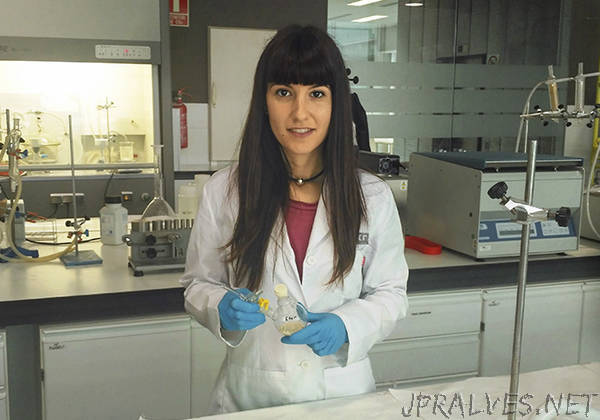
“A study by the UPV/EHU-University of the Basque Country has synthesised polyurethanes with shape memory for the textile and footwear industry
Using shape-memory polyurethanes, the UPV/EHU researcher Míriam Sáenz-Pérez has synthesised various fibres and fabrics that promote sweat evaporation and humidity control and display recovery in excess of 99 %.
Shape memory is a very interesting property making it possible to develop materials that change shape when they are subjected to an external stimulus (thermal, electrical, magnetic, etc.). In recent years, polymers with shape memory have been the focus of attention owing to their outstanding functionality and the possibilities they offer as smart materials. Among them, “shape-memory polyurethanes are a class of polymers that can be synthesised with different types of molecular architectures by varying their composition and by correctly selecting the chemical structure of their components. This gives rise to a range of applications in the automotive sector, biomedicine, adhesives, and the textile or footwear industry”, remarked Míriam Sáenz-Pérez, a researcher in the UPV/EHU’s Department of Physical Chemistry and who currently works at the Footwear Research Centre in La Rioja.
This work focussed on exploring shape-memory polyurethanes for applications in smart fabrics. “The aim was to produce certain fibres or fabrics with shape memory; in other words, materials that are capable of changing shape and adapting to the situation on their own depending on the temperature they find themselves at,” explained Míriam Sáenz. “What we were actually trying to achieve was to get their glass transition (an intermediate temperature point between the melted state and the rigid state of the polymer) to be around 37-38 ⁰C, in other words, similar to that of body temperature, and to get the polymer to be able to change its shape on the basis of that temperature,” she added.
Firstly, a set of polyurethanes with rigid and flexible segments were synthesised. Then their thermal behaviour, mechanical properties, permeability and the effect of shape memory were analysed. In addition, “fibres and fabrics were produced using these polyurethanes in order to gain a deeper understanding of polyurethanes in the textile industry,” said Sáenz.
“The results obtained concluded that polyurethanes synthesised with shape memory offer promising applications in the textile industry,” confirmed the researcher. Likewise, “the effect of shape memory shows that most polyurethanes with shape memory have recovery values in excess of 99%. As far as permeability is concerned,” said Míriam Sáenz, “polyurethane films with shape memory were seen to have the capacity to promote sweat evaporation and humidity control. Polyurethanes in the form of shape-memory fabric also display recovery greater than 99 %, so it can be concluded that these fibres and fabrics could be used in future applications in the textile industry,” concluded Míriam Sáenz.”
